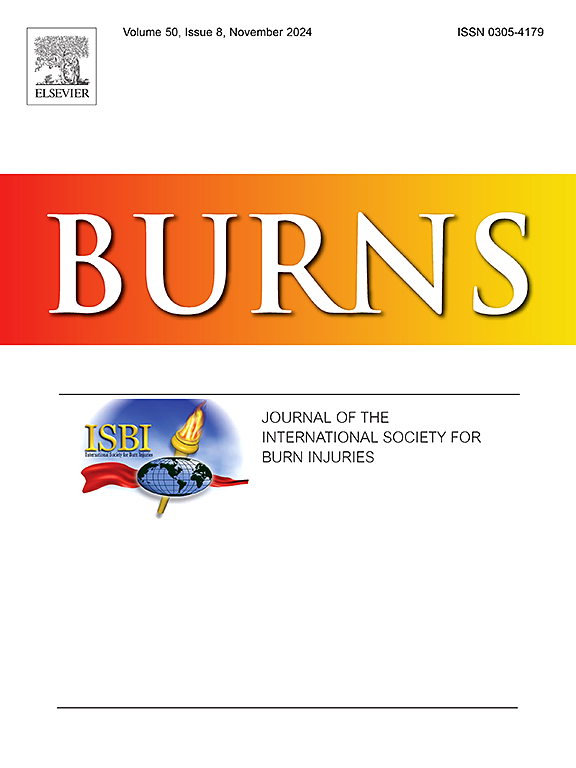Differences in burn injury knowledge among reproductive-age women attending an urban and a semi-rural hospital in Northwest Nigeria: A cross-sectional study
IF 3.2
3区 医学
Q2 CRITICAL CARE MEDICINE
引用次数: 0
Abstract
Objectives
To assess burn injury knowledge and its predictors among reproductive-age women attending an urban and a semi-rural hospital in Northwest Nigeria
Design
A descriptive cross-sectional study
Setting
It was conducted in the general and paediatric outpatient clinics of Aminu Kano Teaching Hospital in Kano (urban setting) and the general outpatient, paediatric outpatient and antenatal clinics of Federal Medical Centre Birnin Kudu (semi-rural setting).
Participant
In 2021, 362 women aged 18–44 years were randomly selected from clinic attendees over six weeks. Of them, 217 were from the urban hospital. Data regarding their sociodemographic characteristics and knowledge of burn injuries was collected using a pretested, semi-structured interviewer-administered questionnaire.
Outcome measure
Knowledge of burn injuries
Results
About 83.4 %, 77.1 % and 77.6 % of respondents had adequate general, primary prevention and overall knowledge of burn injuries, respectively. Their mean overall knowledge score was 18.6 out of 24, but only 55.5 % had adequate first-aid knowledge. The study sites did not significantly differ in burns first-aid, prevention and overall knowledge scores. However, urban respondents were more ignorant about the cause of burns and knew that burn injuries could be fatal. More semi-rural respondents knew that flames and chemicals cause burn injuries. Predictors of overall knowledge were age, educational level, number of children in their household, previously seeing a burn-injured child, and primary source of burns-related information.
Conclusions
The proportion of respondents with adequate overall burn injury knowledge was high; however, knowledge gaps exist among them. Overall, their first-aid knowledge was relatively low. The urban and semi-rural respondents had no significant differences in first-aid, prevention, or overall knowledge of burn injuries. However, knowledge of the causes of burns and burn complications differed between the urban and semi-rural study locations. Therefore, the clinical settings of this study present opportunities for similar burn-related educational interventions.
在尼日利亚西北部一家城市医院和一家半农村医院就诊的育龄妇女在烧伤知识方面的差异:横断面研究
在卡诺的阿米努-卡诺教学医院的普通门诊和儿科门诊(城市环境)以及比尔宁-库杜联邦医疗中心的普通门诊、儿科门诊和产前门诊(半农村环境)开展了一项描述性横断面研究。2021 年,从门诊就诊者中随机抽取了 362 名年龄在 18-44 岁之间的妇女,为期六周。其中 217 人来自城市医院。我们使用一份经过预先测试的半结构化访谈问卷,收集了她们的社会人口学特征和对烧伤知识的了解情况。烧伤知识 分别有约 83.4%、77.1% 和 77.6% 的受访者对烧伤有足够的一般知识、初级预防知识和总体知识。在 24 分的总分中,他们的平均总分是 18.6 分,但只有 55.5% 的人有足够的急救知识。研究地点在烧伤急救、预防和总体知识得分方面没有明显差异。不过,城市受访者对烧伤的原因更无知,他们知道烧伤可能致命。更多的半农村受访者知道火焰和化学品会导致烧伤。年龄、受教育程度、家中儿童数量、曾见过烧伤儿童以及烧伤相关信息的主要来源是影响受访者总体知识水平的预测因素。对烧伤知识有足够了解的受访者比例较高,但他们之间也存在知识差距。总体而言,他们的急救知识水平相对较低。城市和半农村受访者在烧伤急救、预防和总体知识方面没有明显差异。不过,城市和半农村研究地点的受访者对烧伤原因和烧伤并发症的了解程度有所不同。因此,本研究的临床环境为类似的烧伤相关教育干预提供了机会。
本文章由计算机程序翻译,如有差异,请以英文原文为准。
求助全文
约1分钟内获得全文
求助全文
来源期刊

Burns
医学-皮肤病学
CiteScore
4.50
自引率
18.50%
发文量
304
审稿时长
72 days
期刊介绍:
Burns aims to foster the exchange of information among all engaged in preventing and treating the effects of burns. The journal focuses on clinical, scientific and social aspects of these injuries and covers the prevention of the injury, the epidemiology of such injuries and all aspects of treatment including development of new techniques and technologies and verification of existing ones. Regular features include clinical and scientific papers, state of the art reviews and descriptions of burn-care in practice.
Topics covered by Burns include: the effects of smoke on man and animals, their tissues and cells; the responses to and treatment of patients and animals with chemical injuries to the skin; the biological and clinical effects of cold injuries; surgical techniques which are, or may be relevant to the treatment of burned patients during the acute or reconstructive phase following injury; well controlled laboratory studies of the effectiveness of anti-microbial agents on infection and new materials on scarring and healing; inflammatory responses to injury, effectiveness of related agents and other compounds used to modify the physiological and cellular responses to the injury; experimental studies of burns and the outcome of burn wound healing; regenerative medicine concerning the skin.
 求助内容:
求助内容: 应助结果提醒方式:
应助结果提醒方式:


